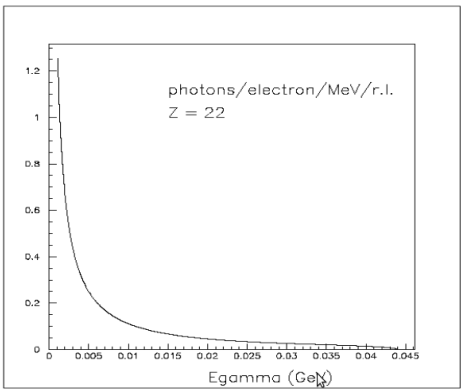Difference between revisions of "Counts Rate (44 MeV LINAC)"
Jump to navigation
Jump to search
| Line 1: | Line 1: | ||
[http://wiki.iac.isu.edu/index.php/PhotoFission_with_Polarized_Photons_from_HRRL Go Back] | [http://wiki.iac.isu.edu/index.php/PhotoFission_with_Polarized_Photons_from_HRRL Go Back] | ||
| − | =LINAC parameters used in calculations= | + | ='LINAC parameters used in calculations'= |
1) pulse width 50 ns <br> | 1) pulse width 50 ns <br> | ||
2) pulse current 50 A <br> | 2) pulse current 50 A <br> | ||
3) repetition rate 300 Hz <br> | 3) repetition rate 300 Hz <br> | ||
| − | 4) energy 44 MeV <br> | + | 4) energy 44 MeV <br><br> |
=Number of electrons/sec on radiator= | =Number of electrons/sec on radiator= | ||
| Line 32: | Line 32: | ||
==steps together...== | ==steps together...== | ||
<math>0.1\ \frac{\gamma 's}{(e^-\ MeV\ r.l.)} \times 3.48 \cdot 10^{-4} r.l. \times 10\ MeV \times 0.47 \cdot 10^{13} \frac{e^-}{sec}=1.64 \cdot 10^{9} \frac{\gamma}{sec}</math><br><br> | <math>0.1\ \frac{\gamma 's}{(e^-\ MeV\ r.l.)} \times 3.48 \cdot 10^{-4} r.l. \times 10\ MeV \times 0.47 \cdot 10^{13} \frac{e^-}{sec}=1.64 \cdot 10^{9} \frac{\gamma}{sec}</math><br><br> | ||
| + | |||
=Collimation factor= | =Collimation factor= | ||
| Line 56: | Line 57: | ||
<math>\frac{19.1\ g/cm^3}{238.02\ g/mol} = 0.08\ \frac{mol}{cm^3} = 0.08\ \frac{mol}{cm^3} \times \frac{6.02\cdot 10^{23}\ atoms}{mol} = 0.48\cdot 10^{23}\ \frac{atoms}{cm^3}</math> | <math>\frac{19.1\ g/cm^3}{238.02\ g/mol} = 0.08\ \frac{mol}{cm^3} = 0.08\ \frac{mol}{cm^3} \times \frac{6.02\cdot 10^{23}\ atoms}{mol} = 0.48\cdot 10^{23}\ \frac{atoms}{cm^3}</math> | ||
| − | + | Target thickness = 1 cm: | |
<math>0.48\cdot 10^{23}\ \frac{atoms}{cm^3} \times 1\ cm = 0.48\cdot 10^{23}\ \frac{atoms}{cm^2}</math> | <math>0.48\cdot 10^{23}\ \frac{atoms}{cm^3} \times 1\ cm = 0.48\cdot 10^{23}\ \frac{atoms}{cm^2}</math> | ||
| Line 65: | Line 66: | ||
==steps together...== | ==steps together...== | ||
| − | <math>8.2 \cdot 10^{7} \frac{\gamma}{sec} \times 130\ mb \times 0.48\cdot 10^{23}\ \frac{atoms}{cm^2} \times 2.4 = 1.2 \cdot 10^{6}\ \frac{neutrons}{sec}</math> | + | <math>8.2 \cdot 10^{7} \frac{\gamma}{sec} \times 130\ mb \times 0.48\cdot 10^{23}\ \frac{atoms}{cm^2} \times 2.4 = 1.2 \cdot 10^{6}\ \frac{neutrons}{sec}</math><br><br> |
| + | |||
=Worst Case Isotropic Neutrons= | =Worst Case Isotropic Neutrons= | ||
| Line 79: | Line 81: | ||
finally we have | finally we have | ||
| − | <math>1.2 \cdot 10^{6}\ \frac{neutrons}{sec} \times \frac{1}{4} \cdot 10^{-4} = 300\ \frac{neutrons}{sec} </math> | + | <math>1.2 \cdot 10^{6}\ \frac{neutrons}{sec} \times \frac{1}{4} \cdot 10^{-4} = 300\ \frac{neutrons}{sec} </math><br> |
'''Therefore, this experiment is do able.''' | '''Therefore, this experiment is do able.''' | ||
Revision as of 03:39, 18 May 2010
'LINAC parameters used in calculations'
1) pulse width 50 ns
2) pulse current 50 A
3) repetition rate 300 Hz
4) energy 44 MeV
Number of electrons/sec on radiator
Number of photons/sec from radiator
bremsstrahlung
in (10,20) MeV region we have about
0.1 photons/electrons/MeV/r.l
radiation length
Titanium r.l. is 3.59 cm
take radiator thickness is
steps together...
Collimation factor
assume we collimate 4-6 % of total # of photons (Alex, GEANT calculation)
then, incident flux on target is
Number of neutrons/sec (yields)
cross section
plot from Berman
in (10,20) MeV region the average cross section for is:
130 mb
target thickness,
Target thickness = 1 cm:
neutrons per fission
2.4 neutrons/fission
steps together...
Worst Case Isotropic Neutrons
Let's say we have:
radius detector = 1 cm
1 meter away
fractional solid angle = <= geometrical acceptance
finally we have
Therefore, this experiment is do able.
